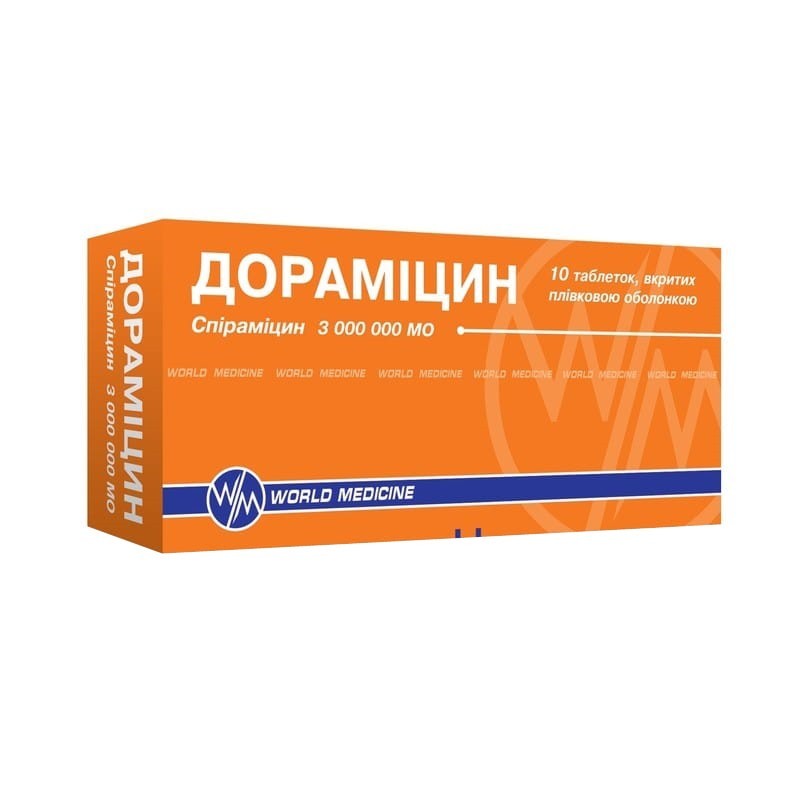



 Secure and encrypted payment processing
Secure and encrypted payment processing We ship to over 40 countries including the USA, UK, Europe, Australia and Japan
We ship to over 40 countries including the USA, UK, Europe, Australia and Japan Guaranteed refund or reship if you haven't received your order
Guaranteed refund or reship if you haven't received your orderspiramycin is an antibiotic of the macrolide group that has a bactericidal effect.
The spectrum of antimicrobial activity. The critical concentration, which allows to differentiate sensitive species of microorganisms from species with intermediate sensitivity, is 1 mg / l; and species with intermediate sensitivity from resistant - 4 mg / L. The prevalence of acquired resistance among certain types of microorganisms may vary depending on geographic location and a specific period. Therefore, it is useful to have local information on the prevalence of resistance, especially in the treatment of severe infections. The data provided only allow us to assess the likelihood of sensitivity of a bacterial strain to this antibiotic. The prevalence of bacterial resistance to spiramycin in France is shown in the table.
| Category | The prevalence of acquired resistance in France (10%),% |
|---|---|
| Sensitive species | |
| Gram-positive aerobes | |
| Bacillus cereus | |
| Corynebacterium diphtheriae | |
| Enterococci | |
| Rhodococcus equi | |
| Methicillin-sensitive strains of Staphylococcus spp. | |
| Methicillin-resistant strains of Staphylococcus spp. * | 50–70 |
| Group B Streptococcus | 70–80 |
| Unclassified Streptococcus spp. | 30–40 |
| Streptococcus pneumoniae | 35–70 |
| Streptococcus pyogenes | 16–31 |
| Gram-negative aerobes | |
| Bordetella pertussis | |
| Branhamella catarrhalis | |
| Campylobacter spp. | |
| Legionella pneumophila | |
| Moraxella spp. | |
| Gram-negative anaerobes | |
| Actinomyces spp. | |
| Bacteroides spp. | |
| Eubacterium spp. | 30–60% |
| Mobiluncus spp. | |
| Peptostreptococcus spp. | |
| Porphyromonas spp. | 30–40% |
| Prevotella spp. | |
| Propionibacterium acnes | |
| Various | |
| Borrelia burgdorferi | |
| Chlamydia spp. | |
| Coxiella burnetii | |
| Leptospira spp. | |
| Mycoplasma pneumoniae | |
| Treponema pallidum | |
|
Moderately sensitive species
(intermediate level of sensitivity in vitro) |
|
| Gram-negative aerobes | |
| Neisseria gonorrhoeae | |
| Gram-negative anaerobes | |
| Clostridium perfringens | |
| Various | |
| Ureaplasma urealyticum | |
| Resistant Views | |
| Gram-positive aerobes | |
| Corynebacterium jeikeium | |
| Nocardia asteroides | |
| Gram-negative aerobes | |
| Acinetobacter spp. | |
| Enterobacteriaceae | |
| Haemophilus spp. | |
| Pseudomonas spp. | |
| Gram-negative anaerobes | |
| Fusobacterium spp. | |
| Various | |
| Mycoplasma hominis | |
* The prevalence of methicillin resistance is characteristic of inpatient departments of hospitals.
Spiramycin activity against Toxoplasma gondii was demonstrated in vitro and in vivo.
Farmak